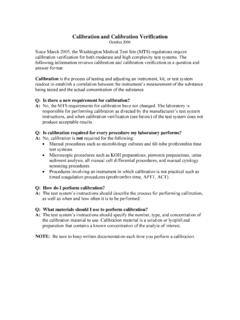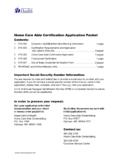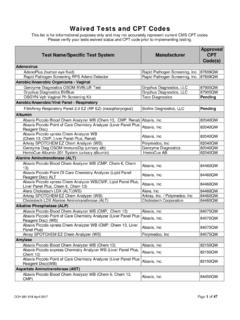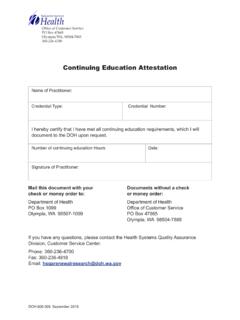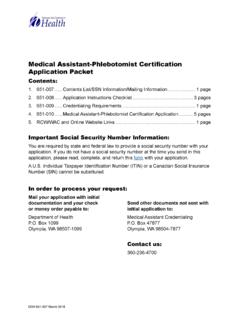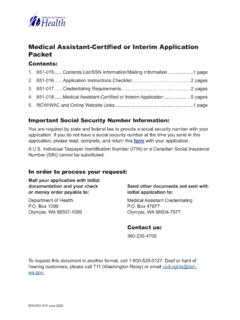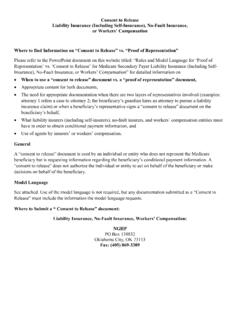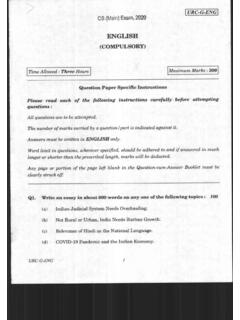Transcription of COVID-19 Morbidity Mortality Race Ethnicity Language Wastate
1 COVID-19 Morbidity and Mortality by race, Ethnicity and spoken Language in washington state washington State department of health January 11, 2022 Page Break To request this document in another format, call 1-800-525-0127. Deaf or hard of hearing customers, please call 711 ( washington Relay) or email Publication Number 420-289 For more information or additional copies of this report: Disease Control and health Statistics Public health Outbreak Coordination, Information, and Surveillance 1610 NE 150th Street, MS: K17-9 Shoreline, WA 98155 Phone: 206-418-5700 (24-hour contact for local health jurisdictions only) Email: Page break COVID-19 Morbidity and Mortality by race, Ethnicity and spoken Language in washington state washington State department of health January 11, 2022 NOTE: Beginning the week of December 23, 2020, probable cases are included in the metrics calculated for Morbidity and Mortality associated with race, Ethnicity , and spoken Language .
2 Probable cases are individuals with a positive antigen test for COVID-19 . Also, as of December 16, 2020, probable cases are included in all case, hospitalization, and death counts on the washington State department of health COVID-19 dashboard. Probable cases since June 2020, when the first antigen results were reported in washington , are now included in the dashboard. This places the report on COVID-19 Morbidity and Mortality by Race, Ethnicity and Spoken Language in washington State in alignment with the washington State department of health COVID-19 Date Dashboard. Overview The impacts of COVID-19 Morbidity and Mortality have not been felt equally by all populations in washington state. The pandemic has exacerbated the underlying and persistent inequities among historically marginalized communities and those disproportionately impacted due to structural racism and other forms of systemic oppression. This report provides an overview of confirmed or probable COVID-19 case, hospitalization, and death rates by race and Ethnicity at state and regional levels.
3 It also provides counts and percentages of confirmed or probable cases and hospitalizations by primary Language spoken. Throughout this report, the COVID-19 case definition includes both molecular testing and antigen testing. Molecular positive cases are considered confirmed cases and antigen positive cases are considered probable cases. All hospitalization, death, and testing data reported here are based on positive molecular or antigen test results. All rates presented in this report are adjusted for age using the washington state population distribution based on the Office of Financial Management s (OFM) April 1, 2020 population estimates by age, sex, race, and Hispanic origin. The rate calculations are for the population groups available from OFM for the washington state population and follow department of health guidelines. Hispanic Ethnicity was assigned first, regardless of race, and then racial groups were identified for those identifying as non-Hispanic.
4 Based on this, the current report includes the following groups: Hispanic; and non-Hispanic race categorizations for white, Black, Native Hawaiian and Pacific Islander, Asian, and American Indian/Alaska Native. While this allows assessment of data by race and Ethnicity groups, this categorization is incomplete and does not reflect the diversity of people and experiences across the state. Additionally, there is a significant lack of race and Ethnicity reporting for confirmed or probable COVID-19 cases and hospitalizations (about 25% missing) and for deaths (about 0% missing). Primary Language spoken is missing for about 67% of cases and hospitalizations. Age information is missing for a small percentage of confirmed or probable cases (about ), and these cases are not included in age-adjusted rates. The lack of data limits our ability to draw firm conclusions; however, there are some concerning patterns reported below. Cumulative age-adjusted confirmed or probable COVID-19 case, hospitalization, and death rates by race and Ethnicity per 100,000 population The table and figures below describe the counts and age-adjusted rates per 100,000 population in washington by race and Ethnicity for confirmed or probable cases, hospitalizations, and deaths for the entire time period from the start of the pandemic through 2022-01-10 based on the specimen collection date.
5 95% confidence intervals are included in the charts. The data show that communities of color are disproportionately impacted by COVID-19 in significant ways, including the following. COVID-19 confirmed or probable case rates Native Hawaiian and Pacific Islander (NHPI) and Hispanic populations have the highest age-adjusted confirmed or probable case rates while Asian and multiracial populations have the lowest case rates. Confirmed or probable case rates for NHPI and Hispanic populations are approximately three times higher than case rates for Asian and multiracial populations. Confirmed or probable case rates for Black populations are approximately two times higher than case rates among Asian and multiracial populations. COVID-19 hospitalization rates among confirmed or probable cases Hospitalization rates among confirmed or probable COVID-19 cases are the highest for NHPI populations and lowest for multiracial populations. NHPI hospitalization rates among confirmed or probable COVID-19 cases are seven times higher than white populations.
6 Hispanic hospitalization rates among confirmed or probable COVID-19 cases are two times higher than white populations. Hospitalization rates among confirmed or probable COVID-19 cases for Black and American Indian and Alaska Native (AIAN) populations are two times higher compared to white populations. COVID-19 death rates among confirmed or probable cases White populations have the lowest death rates among confirmed or probable COVID-19 cases of all race/ Ethnicity groups. NHPI populations have death rates among confirmed or probable COVID-19 cases that are approximately five times higher than white populations. AIAN and Hispanic populations have death rates among confirmed or probable COVID-19 cases that are approximately two times higher than white populations. Black populations have death rates among confirmed or probable COVID-19 cases that are about times higher than white populations. Table 1. Confirmed or probable COVID-19 case, hospitalization, and death count and age-adjusted rates by race/ Ethnicity Race/ Ethnicity Case Count Age-Adjusted Case Rate per 100,000 Hospitalization Count Age-Adjusted Hospitalization Rate per 100,000 Death Count Age-Adjusted Death Rate per 100,000 All Races 991,570 47,798 10,027 131 Unknown 246,244 6,672 24 Hispanic 153,679 6,108 1,068 White 453,029 27,265 7,349 Asian 48,867 2,201 577 Black 41,765 2,386 330 181 NHPI 14,402 1,299 171 Multiracial 15,042 545 148 AIAN 11,549 832 221 Other 6,993 490 139 The following graph indicates the age-adjusted confirmed or probable COVID-19 case rate per 100,000 population by race/ Ethnicity during the time period 2020-01-19 to 2022-01-10 Source.
7 washington Disease Reporting System (WDRS) The following graph indicates the age-adjusted hospitalization rate among confirmed or probable COVID-19 cases per 100,000 population by race/ Ethnicity during the time period 2020-01-19 to 2022-01-10 Source: washington Disease Reporting System (WDRS) The following graph indicates the age-adjusted death rate among confirmed or probable COVID-19 cases per 100,000 population by race/ Ethnicity during the time period 2020-01-19 to 2022-01-10 Source: Electronic Death Registration System (EDRS) and washington health and Life Events System (WHALES) Analysis of confirmed or probable COVID-19 cases, hospitalizations, and deaths by geographic region Regional groupings of washington state counties Some counties may not have sufficient case counts to analyze trends by race and Ethnicity . In order to incorporate data from counties of all sizes, counties were assigned into one of 8 analytic regions (see Map of washington Counties and Analysis Regions below).
8 The regions presented were developed by the washington State department of health in order to better understand geographic differences in disease spread and how disease spread may be changing over time. While infection rates may not be the same within any given region, this regional grouping allows for more specific geographic analyses without excluding any counties or communities due to concerns about smaller numbers. Map of washington counties by DOH analysis regions Missing race/ Ethnicity data by region The North region has the highest percentage of missing race/ Ethnicity data among confirmed or probable COVID-19 cases and the North Central region has the lowest percentage of missing data on race/ Ethnicity , as indicated in the following table. The total number of confirmed or probable cases, and the number and percentage of confirmed or probable cases with missing data are shown in Table 2. Table 2. Counts and percentage of confirmed or probable COVID-19 cases with unknown race/ Ethnicity by DOH analytic region.
9 Region Case Count Cases with Unknown Race/ Ethnicity % Cases with Unknown Race/ Ethnicity East 111,745 28,024 25% North 46,921 14,344 31% Region Case Count Cases with Unknown Race/ Ethnicity % Cases with Unknown Race/ Ethnicity North Central 51,929 10,943 21% Northwest 33,689 9,702 29% Puget Sound 483,164 114,912 24% South Central 121,554 30,739 25% Southwest 74,529 21,344 29% West 66,300 15,412 23% Unknown 2,378 1,186 50% Source: washington Disease Reporting System (WDRS) Includes data from 2020-01-19 to 2022-01-10 Cumulative age-adjusted confirmed or probable COVID-19 case rates by race, Ethnicity , and analytic region The following figures describe the age-adjusted confirmed or probable COVID-19 case rates per 100,000 population by race/ Ethnicity and region. They were calculated using the confirmed or probable cases with known race/ Ethnicity (about 75% of all reported cases). It is important to note that the numeric scale differs across regions, so use caution when comparing two or more regions, as their scales may differ.
10 The last figure (lower right corner) presents the age-adjusted confirmed or probable COVID-19 case rates for the whole state. These data indicate that COVID-19 is found in significant numbers across racial and ethnic groups throughout the state, and it is not confined to certain areas, such as rural, urban, or suburban regions. Population centers in Puget Sound contribute substantially to the counts. However less populated regions, like South Central washington , show larger rate differences by race/ Ethnicity , although they have smaller populations of racial and ethnic minorities. Further, while extreme disparities exist, people of all races and ethnicities are impacted. Source: washington Disease Reporting System (WDRS) Includes data from 2020-01-19 to 2022-01-10 Age-adjusted confirmed or probable COVID-19 case rates by race and Ethnicity per two-week period (Mar 2020-January* 2022) *December 2021 data include all confirmed or probable cases with a specimen collection date through 2022-01-01 to include the most recent, complete two-week period of data collection.
